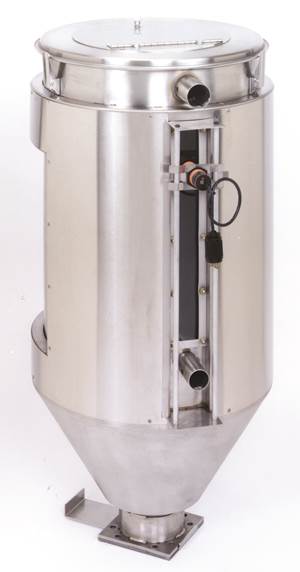Bozzelli’s Dozen Drying Tips
There’s a lot to know about drying—enough to fill a book, at least. But for now, here are a dozen details you need to know, from seasoned injection molding consultant and Scientific Molding trainer John Bozzelli. Scroll down and take his quiz.
1. Automatically monitor filter function with a pressure-differential indicator. If you system does not have one, install one.
2. Keep two sets of filters, one set in use the other being cleaned. Clean with a vacuum, not an air hose. Do not bang the filter to clean it. If you dent it, fines will foul the rest of the dryer.
3. Look into rigging up a thermocouple in the air feed just before the desiccant bed. The air temperature going to the desiccant beds should be below 150 F. If you are running the dryer hotter than 180 F, you’ll need to have an aftercooler on the return line (which should not be insulated) so the air is cooled for the desiccant. The ideal operating temperature for the bed is about 120-150 F (50-65 C).
4. Check your regeneration heater elements regularly. If they are not working properly, you won’t regenerate (dry) the desiccant properly, and it won’t dry your resin as it’s intended to. Put an “idiot light” on the control panel that tells you if the amps drawn by the heater are to specification. Or, you can measure the air inlet temperature to the desiccant bed being regenerated—this should be the temperature required to dry the desiccant. If these two options are not practical for you, measure the air outlet temperature from the bed being regenerated. It must be above 212 F (100 C).
5. Examine the desiccant. Is it still active? Read the supplier’s instructions and you may find a simple test that involves putting dry desiccant into a little bit of water and watching for a temperature rise. Desiccants can become contaminated or ruined by off-gases from processing certain resins. A general rule is to change the desiccant every 18 months.
6. Look for leaks at seals and crushed hoses.
7. Don’t bring the dryer on stream with newly regenerated desiccant before it is cooled down properly. Otherwise you might wind up with a 200-lb pellet clump. With some dryers, you can get a slug of 350 F (180 C) air going into the drying hopper when the system switches desiccant beds.
8. Measure dewpoint. Run at less than -25 F (-32 C) dewpoint—better yet, a good dryer should run at -40 F/C dewpoint. The dewpoint of the drying air does not tell you if the resin is dry, just whether the air is dry enough to do the job.
9. Test some dried resin for moisture content to know if you are drying correctly. Use a moisture-specific method, not simple weight loss. Not all volatiles driven off a resin are water. Use Karl Fischer, dielectric, or other moisture-specific sensors.
10. Do not convey dried material from a central hopper to the machine, or leave it in the machine’s hopper, without a blanket of dry air. Once dry, most resins will pick up moisture in 15 to 30 min.
11. Note where the dry air enters the hopper and meets the resin. Hot air will only travel upward, the path of least resistance. The bottom of the hopper is usually blocked. Therefore, any resin below the dry-air distribution hardware (look for a dip tube) must be drained and put back on top of the hopper load before you start molding.
12. If you dry cellulosics, TPUs, flexible PVC, TPVs, and some other soft-touch resins, check the desiccant’s condition every six months, because these resins emit volatiles that can ruin desiccant.
Related Content
Five Quick Steps Toward Better Blending
Rising costs of resins and additives, along with higher demands for quality and use of regrind, place a premium on proficient blending. Here are some steps to get you there.
Read MoreThe Effects of Stress on Polymers
Previously we have discussed the effects of temperature and time on the long-term behavior of polymers. Now let's take a look at stress.
Read MoreKnow Your Options in Injection Machine Nozzles
Improvements in nozzle design in recent years overcome some of the limitations of previous filter, mixing, and shut-off nozzles.
Read MoreBozzelli’s Guide To Specifying a Dryer
Here's a list of 17 things to do when looking for new drying equipment.
Read MoreRead Next
For PLASTICS' CEO Seaholm, NPE to Shine Light on Sustainability Successes
With advocacy, communication and sustainability as three main pillars, Seaholm leads a trade association to NPE that ‘is more active today than we have ever been.’
Read MoreMaking the Circular Economy a Reality
Driven by brand owner demands and new worldwide legislation, the entire supply chain is working toward the shift to circularity, with some evidence the circular economy has already begun.
Read MorePeople 4.0 – How to Get Buy-In from Your Staff for Industry 4.0 Systems
Implementing a production monitoring system as the foundation of a ‘smart factory’ is about integrating people with new technology as much as it is about integrating machines and computers. Here are tips from a company that has gone through the process.
Read More
.jpg;width=70;height=70;mode=crop)





















